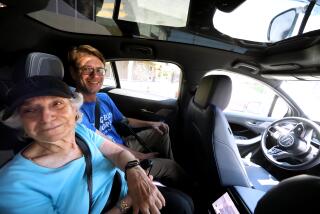Israel turns to robotics to boost students’ interest in high-tech industry
TEL AVIV — It looked like high school basketball with high-tech bumper cars.
Cheerleaders, drummers and somebody in a frog outfit worked the crowd into a frenzy. The buzzer sounded and 4-foot-tall robots clattered into action on a make-believe lunar surface.
Guided from the sidelines by teenagers with joysticks, the three robots on each alliance scooped up plastic “moon rocks,” loaded them into hoppers and tried to score by lobbing them into trailers hitched to rival robots.
Music blared and giant video screens zoomed in on the mechanical gladiators. With 20 seconds to play in the championship match, the blue alliance held a slim lead over the reds.
Israel’s high-tech industry is in a deep slump, but high school robotics is booming. The recent competition at a Tel Aviv sports arena is part of a drive to expand the country’s pool of homegrown talent and maintain its edge as a global technology power.
In the 1990s Israel profited from a wave of immigrant engineers and technicians from the former Soviet Union. High-tech exports now account for nearly half of Israel’s trade income. But that source of brainpower has slowed to a trickle.
The search for a new generation of innovators now reaches into Israel’s poorest corners. Aided by corporate sponsors, young Arab students, ultra-Orthodox Jews and Ethiopian Jewish refugees are building robots to go mano a mano with the best radio-controlled contraptions of their wealthier Israeli peers.
They’re all having a blast -- with the game itself, and the celebrity that comes with success.
“I didn’t know robotics existed before,” said Guy Atanaw, 18, who arrived five years ago from rural Ethiopia. “Now it’s a natural part of my life.”
Atanaw, a shy, easygoing student who giggled through much of an interview, is captain of the robotics team at Yemin Orde Youth Village. Its 500 boarding-school students are disadvantaged immigrant children, some of them orphans. Ethiopians dominate the team, which is sponsored by the Israeli navy and gets access to machinery and tools at its shipyards in nearby Haifa.
The team’s robot, RobOrde, was part of the red alliance in the recent Tel Aviv match, a contest to determine Israel’s qualifiers for the FIRST Robotics Competition starting Thursday in Atlanta.
That U.S.-based high school tournament was launched in 1992 by New Hampshire inventor Dean Kamen, known for his self-balancing upright scooter, the Segway Personal Transporter. Schools from six countries are competing in this year’s final.
Since Israel began sending competitors in 2005, the number of participants in its national qualifying round has grown fivefold, to about 1,200 students from 47 high schools, more than any other country except the United States and Canada.
President Shimon Peres has launched a program to expand high school robotics and lure back Israeli high-tech specialists who work abroad.
In a pep talk at the Tel Aviv arena, the 85-year-old president reminded the competitors that Israel, a country with few natural resources, needs not only peace with its neighbors but also human ingenuity.
“You mustn’t be afraid to dream,” he said, urging the contestants to create clean energy, break Israel’s dependence on foreign oil and conquer high-tech markets abroad. “As a country, either we’re in the first ranks of technology or we’re nothing.”
His remarks reflected concern that Israel, home to numerous high-tech giants and about 2,000 start-ups, is slipping. As the global economic downturn wipes out customers in North America, Europe and Asia, Israeli high-tech exporters have laid off an estimated 8,000 workers since October.
As the slump deepens, said Barak Yanir, general manager of Motorola South Israel Ltd., young Israelis are starting to drift from engineering studies into such traditional fields as medicine and law.
Even before the downturn, Israel was producing just 8,000 engineering graduates per year, about 4,000 fewer than it needed, according to Asaf Agmon, a retired air force general who heads the Fisher Bros. Institute for Air & Space Strategic Studies.
“That’s where robotics comes in,” said Agmon, who supervises Israel’s high school competition. “Schools that take part end up sending double the number of students to university engineering programs than the national average. The hands-on experience captivates these kids.”
Six weeks before the competition, each school receives an identical kit of nuts, bolts, sprockets, washers, gears, electronics and a joystick, paid for by a corporate sponsor. With it comes a book of complex rules of the game, which change every year.
There are no assembly instructions; the students simply must imagine how to build a robot.
For Yemin Orde’s 25-member team, it was a crash course in engineering, computer-assisted modeling, programming and thinking outside the box.
They spent five weeks building a prototype designed to walk on the low-friction surface, lifting two of its wheels at a time.
When that failed, they spent the final, frantic week reinventing the rolling robot RobOrde.
“It’s a brainstorming process,” said Atanaw, the team captain. “There is tension as well as a sense of partner- ship. When you’re building the robot, you’re busy with the technology. But once you’re on the court, it’s a sport and you want to win. You want to be on the side that’s smiling after the game.”
With its red alliance trailing, Rob- Orde scored in the final 20 seconds, launching a “super cell” worth 15 points into the trailer of a blue robot hemmed in by two red rivals.
It was the basketball equivalent of a game-winning 3-point play. The red alliance won, 66 to 65, eking out a trip to Atlanta.
“A few years ago, those kids were shepherds in Africa,” said Agmon. “Now they’re Israel’s high-tech future.”
--






